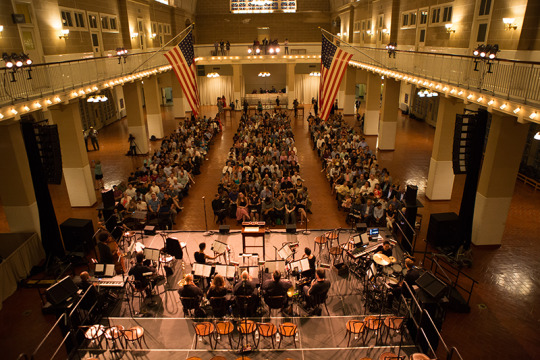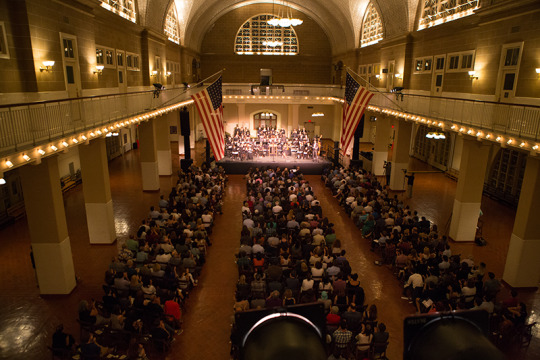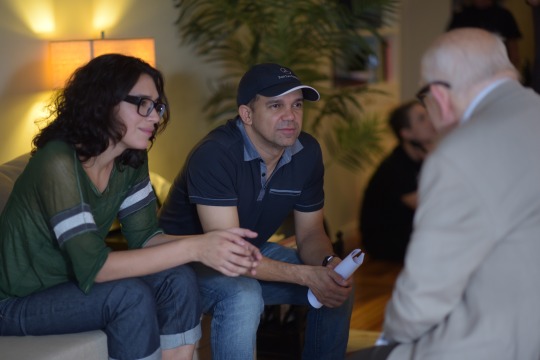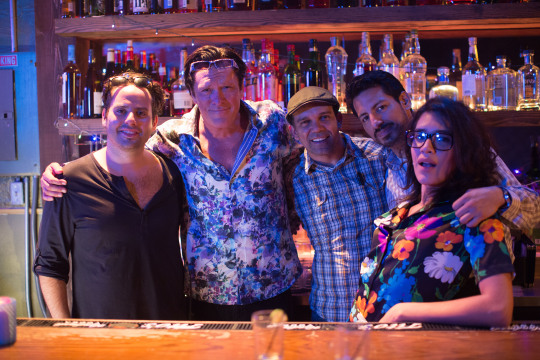Fiscal Sponsorship Grit II: Work in Progress Highlights
“I like to tell stories about communities that lack meaningful structures of support. I feel compelled to tell stories that strike me on a human level.” – Flavio Alves, Project Director, The Garden Left Behind
Immigration and assimilation in the United States are timely themes addressed in Ragtime on Ellis Island and The Garden Left Behind through their respective mediums of theatre and film. Both of these fiscally sponsored projects are mid-way through production and join NYFA Current to candidly discuss the roles of fundraising and collaboration in creating narrative-based art.

Q & A with Sammi Cannold, Project Director of Ragtime on Ellis Island
NYFA: What is Ragtime on Ellis Island?
SC: Ragtime on Ellis Island is a project aimed at presenting the classic American musical Ragtime on the historic site of Ellis Island. Ragtime features the stories of immigrants passing through Ellis Island at the turn of the 20th century and accordingly, this project seeks to put Ragtime’s epic historically-based material in dialogue with the authentic site of Ellis Island and all that it represents.
NYFA: What phase of the project are you in?
SC: This summer, on August 8, 2016, our Ragtime on Ellis Island team mounted a one-night developmental concert in the island’s historic Registry Room for an audience of 450. The concert was narrated by Brian Stokes Mitchell, who originated the role of Coalhouse Walker Jr. on Broadway, and featured Brandon Victor Dixon, Aisha Jackson, Laura Michelle Kelly, Andy Mientus, Michael Park, Robert Petkoff, Shaina Taub, and a cameo by Georgia Engel. The Registry Room is the hall through which 12 million immigrants passed between 1892 and 1954, so it meant quite a lot to us to perform in that space!
Following the concert, our team is now hard at work to plan what may be next for the project. So, we’re now teasing out how we might create a full and fully staged production of Ragtime either on Ellis Island or somehow in dialogue with Ellis Island.
NYFA: How did you become interested in site-specific theatre and what do you think this medium brings to an audience?
SC: There was an amazing grant at Stanford, where much of our Ragtime on Ellis team went to college, called the ReDesigning Theater grant funded by Carole Shorenstein Hays. The grant encouraged applicants to take traditional pieces of theater and reinvent them by thinking out of the box particularly in regard to space, so I decided to apply to direct the musical Violet on a moving bus. I received the funding and mounted the production at Stanford in November of 2013. As a result, I fell head over heels in love with the genre of site-specific theater. There’s something incredibly magical about putting stories in dialogue with authentic spaces and developing a relationship between them wherein the story enhances the site and the site enhances the story. And there’s something about that combination that allows the audience to also feel like they are a part of the story. For example, on Violet, the opening number is called “On My Way,” and because in our production, the audience was on the bus with Violet and her companions, when the cast sang “And I am on my way,” audience members too felt like they were on their way; the bus was quite literally taking them on a journey.
I’ve also fallen in love with this medium, because I’ve had the good fortune of assisting directors who are masters of ‘theater in 360 degrees,’ site-specific theater, and/or ‘immersive’ theater—Rachel Chavkin, Allegra Libonati, and Diane Paulus. Observing and learning from them, largely through their work at the American Repertory Theater (which places great value on the aforementioned genres), has been and continues to be instrumental in the construction of Ragtime on Ellis Island.
NYFA: Why did you choose NYFA Fiscal Sponsorship?
SC: In initial planning for our developmental concert, our team decided that the financial strategy for the piece mandated a donation-based model, because turning a profit (and thereby using an investment-based model) felt fairly impractical given the massive expenses of ferry transportation, insurance, island rental, etc. We learned that donors were eager to support the project, but that being able to provide them with a reputable middleman for their donations, tax deductibility was critical.

NYFA: You navigated numerous logistical barriers to produce the Ragtime on Ellis Island development concert, as Ellis Island is a National Park and only accessible by ferry. What advice do you have for others interested in performing in non traditional spaces?
SC: I think the biggest logistical lesson I’ve learned thus far from working in non-traditional spaces is that having a team of willing, resourceful, and excited collaborators is paramount. The common denominator with performing in non-traditional spaces is that they often aren’t built for theatrical performances, so theater artists going into them need to think out of the box. The young artists working behind-the-scenes on our August concert were simply spectacular in their willingness to go the extra mile and develop creative solutions in service of their passion for this wacky project. For adventures like this, you want people by your side who are willing to say, “it’s too bad that a 3D model of Ellis Island doesn’t exist, but that’s okay, because I’ll just make one myself!”
The biggest artistic lesson I’ve learned thus far from site-specific theater is that the work is most powerful when it not only exists in, but more importantly, embraces and celebrates the site. For example, for our concert, it was very important to our team that we didn’t use any traditional theatrical drapery in our scenic design, because unlike in a theater, we weren’t trying to hide the building, we were trying to showcase it.
NYFA: What is next for Ragtime on Ellis Island?
SC: We’re developing several ideas for the future of the project. Of course, doing a long-running full and fully-staged production of Ragtime in the Registry Room on the island has always been and remains our dream for the future of the piece. That said, we learned quite a lot about the obstacles related to working on Ellis Island from our developmental concert. Namely, any time you do any event on Ellis Island, all of your equipment needs to be struck during the day to accommodate the island’s 20,000 general public visitors. This makes setting up an effective theatrical sound system near impossible, especially given that the room is cavernous and built with glossy red bricks. There’s also the obstacle of getting large numbers of audience members over on ferry boats. So, we’ve also been exploring ideas like Ragtime on the river (in which we’d do the show on a historic boat that would sail by Ellis Island, the Statue of Liberty, Harlem, etc. over the course of the show) or Ragtime at the statue (in which we’d ask the National Park Service about the possibility of performing on the exterior of the new museum they’re building on Liberty Island). The thinking behind all of these ideas is to preserve the dialogue between the story and the site(s), so we’re excited to see what’s next!

Q & A with Flavio Alves, Project Director, The Garden Left Behind
NYFA: What is The Garden Left Behind?
FA: The Garden Left Behind is an independent feature film that tells the story of a Mexican transwoman and her grandmother struggling to build a life for themselves as undocumented immigrants in New York City.
NYFA: What phase of the project are you in?
FA: We are in post-production, but our goal is to be able to finish the film by the end of February 2017.
NYFA: What drives your interest in making films about marginalized communities? What do you hope viewers take away from your work?
FA: As an independent filmmaker, I like to tell stories about communities that lack meaningful structures of support. I feel compelled to tell stories that strike me on a human level, specifically about senior citizens, Latinos, and members of the LGBT communities. I enjoy the inspirational yet troubling stories that come from marginalized communities. These are the stories that compel me to make a difference. When I make a film, my hope is that audience will be compelled just as I was.
NYFA:What steps are you and the production team taking to meet your goal of “empowering voices from the community?”
FA: My producer, Roy Wol, and I believe that empowering marginalized communities means getting them involved on both sides of the camera. On The Garden Left Behind, we had several members of the trans community helping us to tell their own stories by working with us in different capacities. This included everything from script editors to production assistants.
NYFA: Your short Tom in America was also fiscally sponsored by NYFA. What fundraising lessons did you learn from Tom that you are bringing to The Garden Left Behind?
FA: Every movie I’ve made is different, but I think there were some lessons to be learned from previous films, especially Tom in America. As filmmakers, we have to explore every tool available to help us fund our projects, but we realized that we needed much more time during pre-production to put these tools to good use. Though it is possible to raise money with grants, a professional package can’t be put together overnight. For The Garden Left Behind, it took us about a year to apply to every grant available; nevertheless, it required an army of dedicated workers doing research, and writing grant proposals. We ended up using that same team to help lower production costs. This included: making deals with vendors and crew members, getting sponsors, searching for cheaper locations, product placement, etc.

NYFA: This spring you launched an #eBayMyFilm crowdfunding campaign, that allows folks to contribute no-longer needed objects and your team sells them on eBay. What is this fundraising process like?
FA: The process is no different from raising money on any other crowdfunding site, like Kickstarter and Indiegogo. The fundamental difference is that instead of money, we ask for unneeded, forgotten goods. Our campaign has sold hundreds of products ranging from a Nikon DSLR camera, to used baseballs; nothing is out of the question! Every item is appreciated as each donation brings us closer to our goal of producing a vibrant, socially-inspiring film. The success from this campaign made The Garden Left Behind the first independent film to be funded substantially through donations and sales via eBay.
NYFA: What are your favorite objects for sale?
FA: My favorite objects are always the small electronic items. They are typically expensive, easy to storage, and cheap to ship. This includes items such as old cell phones, cameras, and laptops.
NYFA: What are your next steps in production?
FA: We aim to continue raising money to finish post-production. We also plan on further engaging the Latino, aging, and LGBT communities to help spread the word about our film.
NYFA Fiscal Sponsorship’s next quarterly no-fee application deadline is December 31, 2016 and you can learn more about NYFA’s Fiscal Sponsorship program here. Read more about other exciting projects utilizing sponsorship, in our NYFA Fiscal Sponsorship Directory.
Image Credits: courtesy of Ragtime on Ellis Island development concert and courtesy of The Garden Left Behind.





